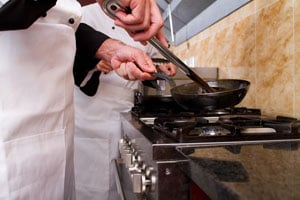Culinary confidential
Peek behind the scenes as a top local restaurant prepares for its Friday-night crowd

Hot-tempered chefs. Disorganized staffs. Mountains of dirty dishes. Thanks to Anthony Bourdain’s book Kitchen Confidential and the Fox TV show Kitchen Nightmares, restaurant kitchens have earned a rap as hotbeds of stress, chaos and disorder. But what’s it really like behind the scenes as a popular restaurant’s staff readies for its Friday-night diners? To find out firsthand, we recently visited the kitchen at Café Panache in Ramsey (201-934-0030, www.cafepanachenj.com), the critically acclaimed, 25-year-old local favorite renowned for its eclectic fare. We were eager to observe the kitchen’s inner workings—and snag a few tips from owner and executive chef Kevin Kohler. Read on for an inside look:
It’s 4:30 p.m. on a sunny Friday afternoon when I enter Café Panache’s small but bustling kitchen. With a team of nine (two chefs, five cooks, two dishwashers) packed into the space and several stove burners and ovens in use, the room is hot, but the sweet aroma of fresh veggies provides a pleasant distraction.
“We usually serve about 120 people on a typical Friday night,” Kohler says with a smile as he seems to perform a multitude of tasks at once. When not bouncing back and forth from a large walk-in fridge containing shelves stocked with ingredients and meal preparations made earlier that day, he’s hovering over a flaming stove to cook all of the hot appetizers for the evening, including ravioli filled with filet mignon, artichoke soup with crispy poached and fried eggs, and shrimp for a warm salad served with a dressing of lobster oil, Spanish red peppers and smoked paprika.
Glancing around, I realize Kohler isn’t the only staffer working at a whirlwind pace: Each cook helps prepare for the night’s dinner by diligently manning different stations of the kitchen. While the sous chef carefully assembles sea bass in cartoccio and other entrées, the dessert cook washes and chops bright-red strawberries for a fruit tart and mixes ingredients for a flourless chocolate cake. Meanwhile, the garde manger, the cook in charge of salads and cold appetizers, is crushing ice for a cold oyster dish and slicing Serrano ham with a meat cutter. Unlike those Gordon Ramsay exposés, this kitchen seems organized and efficient, like a well-oiled machine.
“I usually get here at 8 a.m., and a lot of the other cooks are here by 10 a.m.,” says Kohler, an exceedingly friendly and unassuming head chef, sporting a pair of shorts under his white apron. “For us, preparing early is key. Then when customers arrive for dinner, we’re ready to roll.”
Such advanced preparation is critical, considering the restaurant makes all dishes from scratch daily, down to its ice cream, sorbet, cakes, pastas, stock and soups. Kohler also reveals that he even handpicks produce from the fields at Abma’s Farm in Wyckoff just about every day. “I like to use what I pick the day I pick it,” he explains as he lets me taste samples of his freshly plucked radishes and arugula, which wow me with their freshness.
The mastermind behind each recipe, Kohler also changes around the menu—usually consisting of about 10 entrées, 10 appetizers and seven desserts— every few days, depending on what’s in season and available on the market. Highlights of tonight’s offerings include free-range pecan chicken with wildflower honey Dijonaise, braised filet mignon with caramelized shallots and a burgundy wine reduction, and oven-roasted Atlantic salmon with sweet corn and spring onions—each beautifully presented and cooked to perfection.
“Salmon bruschetta!” cook Emily Johnson shouts after reading an appetizer order at around 5:30 p.m., when the restaurant begins seating customers for dinner. “As the ‘expeditor’ on the line of cooks, Emily has a really important position,” Kohler explains. “She calls out the hot and cold orders to the other cooks, and communicates with the waiter to let them know when to pick up dishes. She also finishes plates by placing the final sauces and herbs on top.”
It’s the start of a long, busy night to be sure, but thanks to hours of prep, the team seems calm and collected. Still, one question lingers in my mind (and stomach): What happens to food left over at the end of the night? “We have no leftovers,” Kohler says. “Everything is cooked to order, and my philosophy is to run out at the end of the night. When restaurants don’t, you know something’s wrong.”
Tips from the toque
Executive chef and owner Kevin Kohler gives advice for cooking up a tasty feast:
- When cooking fish in a pan: Lower the heat when the fish is browned, then flip the fish and allow it to steam with a second pan placed on top. “This will give you a juicier, more flavorful finish,” says Kohler.
- When refrigerating ingredients for a meal, cover as tightly as possible with clear wrap to preserve freshness.
- After removing red meat from the refrigerator, let it sit until it reaches room temperature (about 30 minutes) before cooking. “The meat will be more tender this way,” says Kohler.
- Never refrigerate tomatoes. “They’ll lose their juiciness and flavor,” Kohler says.
- Forgo frozen veggies for fresh. “I like to cook veggies raw in olive oil and serve them al dente,” says Kohler.
Around Café Panache’s kitchen
- PASTA STATION: Here pastas are homemade with fresh dough rolled out daily using a hand-cranked pasta maker. At Café Panache, the dessert cook also mans this station, and earlier this afternoon he made ravioli and tagliatelle.
- WALK-IN FRIDGE: Chefs are constantly in and out of this large, closet-sized refrigerator, which contains ingredients the restaurant stocks up on (butter, milk, mushrooms), plus dinner preparations made earlier in the day, including more homemade pastas, cooked lobster and mussels.
- BUTCHER AREA: Here the garde manger uses a meat cutter to slice Serrano ham, filet mignon, carpaccio and more.
- PICK-UP: Chefs place dishes on this small table at the entrance of the kitchen for waiters to pick up and deliver to customers. “Unlike many other restaurants, we don’t have heat lamps where the food dries out before being brought to tables,” says Kohler. “We make sure the food is delivered hot and fresh.”
- DESSERT STATION: All desserts are homemade fresh each day, such as the crème brûlée, flourless chocolate cake and strawberry tarts. “We might serve about 100 desserts on a given night, since almost everyone orders it,” says dessert chef Saul Ascencio as he shakes powdered sugar atop a pan of strawberry tarts. The area also contains a small refrigerator that stores homemade sorbet and ice cream.
- DISHWASHERS: Two staffers tenaciously clean plates, pots, pans and utensils in large sinks throughout the whole evening. “About 10 pots are dirtied per customer,” says Kohler.
ONE ENTRÉE: A timeline
Ever wonder what happens in the kitchen after you order an entrée? “We cook dishes in 5 to 20 minutes,” says executive chef Kevin Kohler. “If a restaurant takes longer than that, it can indicate a lack of organization and preparation behind the scenes.” Here’s how the team prepares a customer favorite: baked sea bass in cartoccio with oven-roasted tomatoes.
- Start: The waiter passes handwritten orders to Kohler, who places it on “the slide,” a metal strip above a prep table where orders are posted. Expeditor Emily Johnson calls out the order, and sous chef Nelson Rojas quickly begins assembling.
- Minutes 0–10: Rojas brushes a teaspoon of lobster oil onto a piece of parchment paper, and places a piece of sea bass on top of the paper. Next, he drizzles more lobster oil on top of a sliced tomato and sprinkles it with salt, pepper, one chopped shallot and fresh rosemary. He then places the tomato on the sea bass, tops it with a second piece of sea bass and drizzles more lobster oil on top. Lastly, Rojas folds the parchment paper into a tight package to seal in the juices.
- Minutes 10–20: Rojas places the wrapped fish in a 400-degree oven, letting it bake for about 10 minutes.
- Finish: The fish is plated and placed on the pick-up table, ready for delivery by the wait staff. “This is a completely light, healthy dish that’s really flavorful and easy,” says Kohler.

